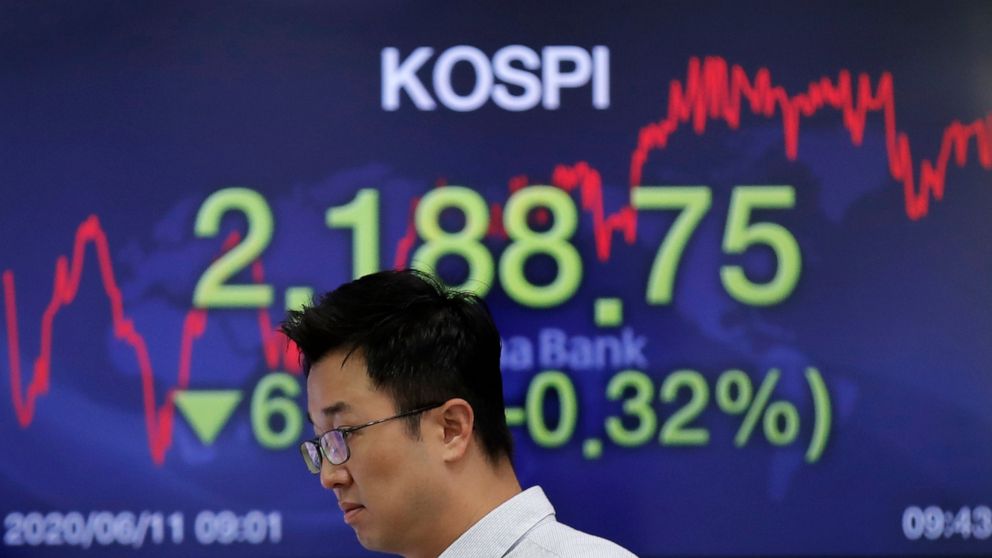Stocks fall sharply on Wall Street as investors turn jittery
Stocks are down sharply lower on Wall Street as investors turn jittery once again in the face of rising numbers of coronavirus infections in many U.S. states and countries
By
ALEX VEIGA AP Business Writer
June 11, 2020, 4:19 PM
4 min read
4 min read
TOKYO — Stocks and bond yields are down sharply on Wall Street as optimism that the reopening of businesses would drive a relatively quick economic recovery fades amid rising coronavirus cases in many U.S. states and countries.
The S&P 500 was down 3.3% in morning trading Thursday, extending its losses into a third straight day. The benchmark index is now on track for its first weekly drop in four weeks. Technology, financial, industrial and health care stocks accounted for much of the market’s broad slide. Energy stocks were the biggest losers as crude oil prices fell sharply. Bond yields fell and the price of gold surged as worried investors shifted money into the traditional safe-haven assets.
European and Asian markets also fell. The global markets sell-off came a day after the Federal Reserve warned that the road to recovery from the worst downturn in decades would be long.
Stocks have been rallying over the past two months, at first following emergency rescues by the Fed and Congress, but more recently on investor optimism that the economy will bounce back by the end of the year, if not sooner, as businesses reopen and people go back to work. But much uncertainty remains over how quickly economies can recover from the pandemic, given that the numbers of infections and fatalities are still rising in many countries.
In the U.S., Texas and Florida were among the states reporting jumps in the number of coronavirus cases after precautions were relaxed last month. The total number of U.S. cases has now surpassed 2 million.
The Dow Jones Industrial Average was down 1,049 points, or 3.9%, to 25,941. The Nasdaq composite, which was coming off an all-time high, slid 2.4%. Small company stocks continued to bear the brunt of the selling. The Russell 2000 index was down 4.7%.
Bond yields fell. The yield on the 10-year Treasury yield slid to 0.67% from 0.74% late Wednesday, a big move. Last Friday it briefly moved above 0.90%.
Oil prices fell sharply. Benchmark U.S. crude oil for July delivery was down 8.3% at $36.33 a barrel. Brent crude oil for August delivery was off 6.9% at $38.87 a barrel.
All but a handful of the companies in the S&P 500 were down. MGM Resorts International, Delta Air Lines and PVH, owner of the Calvin Klein and Tommy Hilfiger brands, were among the biggest decliners. Each was down more than 10%.
Markets in Europe were broadly lower. France’s CAC 40 was down 3.1% and Germany’s DAX dropped 2.8%. Britain’s FTSE 100 fell 2.7%. Stock markets in Asia closed lower.
The Labor Department said Thursday that about 1.5 million people applied for U.S. unemployment benefits last week, another sign that many Americans are still losing their jobs even as the economy begins to gradually reopen. The latest figure marked the 10th straight weekly decline in applications for jobless aid since they peaked in mid-March when the coronavirus hit hard. Still, the pace of layoffs remains historically high.
Other jobs data have been more encouraging. A report on Friday showed that the U.S. job market surprisingly strengthened last month as employers added 2.5 million workers to their payrolls. Economists had been expecting them instead to slash another 8 million jobs.
That report helped stoke optimism among investors that the economy can climb out of its current hole faster than forecast. But the Fed estimated Wednesday that the economy will shrink 6.5% this year, in line with other forecasts, before expanding 5% in 2021. It also expects the unemployment rate at 9.3%, near the peak of the last recession, by the end of this year. The rate is now 13.3%.
The central bank said it would keep providing support to the economy by buying bonds to maintain low borrowing rates and forecast no rate hike through 2022, which could make it easier for consumers and businesses to borrow and spend enough to sustain an economy depressed by business shutdowns and high unemployment.
![]()


